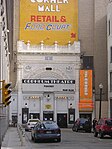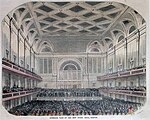Manufactory House
1768 in Massachusetts1768 in the Thirteen Colonies18th century in BostonBuildings and structures demolished in 1806Buildings and structures in Boston ... and 2 more
Industrial buildings completed in the 18th centuryMassachusetts in the American Revolution
The Manufactory House in Boston, Massachusetts, was a linen manufactory built in 1753 to provide employment for local women and girls. The business failed, and the building was rented out to various tenants. In 1768, it was the site of a standoff between townspeople and occupying British soldiers. Governor Francis Bernard had offered the use of the building to the 14th regiment, but the building's existing tenants refused to leave. The incident, although minor, was arguably the first violent confrontation between Americans and British soldiers.
Excerpt from the Wikipedia article Manufactory House (License: CC BY-SA 3.0, Authors).Manufactory House
Tremont Street, Boston Downtown Boston
Geographical coordinates (GPS) Address Website Nearby Places Show on map
Geographical coordinates (GPS)
| Latitude | Longitude |
|---|---|
| N 42.356883333333 ° | E -71.0615 ° |
Address
David J. Sargent Hall
Tremont Street 120
02108 Boston, Downtown Boston
Massachusetts, United States
Open on Google Maps











